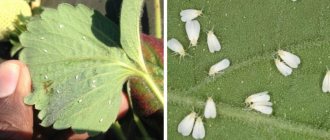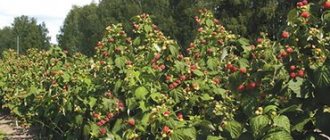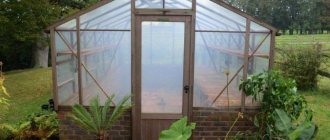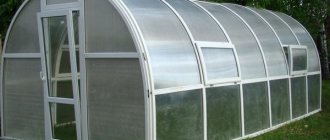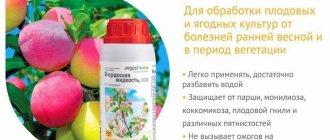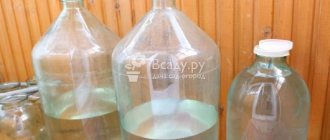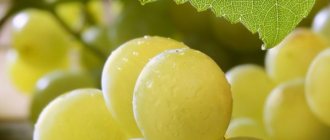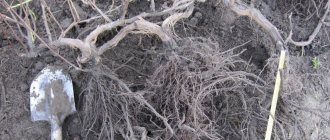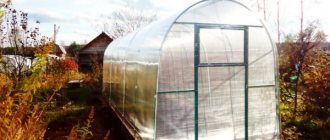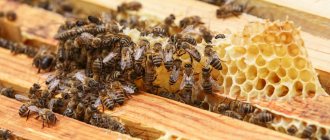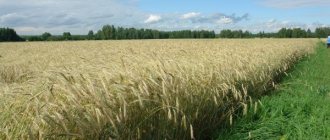History of the origin of the mixture
Not only scientists, but also amateur gardeners were searching for a universal means to protect plants from pests. Treatment with special solutions sometimes got rid of fungi, but made the plants weak and painful.
A real breakthrough was the invention of the French botanist Pierre Millardet. The professor was teaching at the University of Bordeaux at the time and was working on finding a way to rid vineyards of the mold fungus Plasmopara viticola. It was there that the discovery of the first fungicide in history , which later received its name in honor of the city of Bordeaux. The scientist himself was awarded great praise and recognition. After his death in 1902, a bronze bust of him was installed at the university.
Bordeaux mixture is a mixture of water, copper sulfate or, as it is also called, copper sulfate with calcium hydroxide, popularly known as slaked lime. The success of the experiment lay in maintaining the correct proportions. The magic solution has high fungicidal properties that destroy microorganisms harmful to plants.
You don't need to be a scientist to make the mixture. The solution is easy and quick to prepare, but the proportions and precautions must be strictly observed.
Using Bordeaux mixture in the garden
Bordeaux mixture is widely used in horticulture and gardening for the treatment of fruit trees, vegetables and ornamental plants. It will protect apple and pear trees from scab, fruit rot, leaf spot and rust. It will protect plums, cherries and cherry plums from gray rot, monilial burn and cocomycosis. Grapes and roses will relieve anthracnose, septoria, mildew, cancer and infectious burns.
Bordeaux mixture is not only a universal remedy for combating many fungal diseases, but also a rich source of copper. This microelement is necessary for the plant for rapid growth and development, and in case of copper deficiency, chlorosis occurs.
Analogues of the product
People who are familiar with all the features of Bordeaux solution often do not want to use it and look for analogues. There are several drugs that have similar properties for protecting grape bushes. Common remedies include Kuproksat and Hom. They are distinguished by their affordable price and effective therapeutic effect. Many winegrowers use them to treat diseases and prevent their occurrence.
How does the liquid work?
A 3% solution is most often used to treat plants. The best effect is achieved at the beginning and end of the growing season. The first spraying procedure is carried out in early spring, during the formation of buds, and the last one in late autumn. This treatment is called eradication spraying because of its effectiveness in combating diseases.
In the intervals between the main sprayings, the plants are treated with a 1% mixture of Bordeaux mixture. At the end of spring, summer and early autumn, the green parts of the plant are generously sprayed with the mixture.
Important! It is highly recommended to apply during cool, dry weather such as early morning or evening. During heat or high humidity, you can cause burns to the foliage and damage the plants.
Safety regulations
Like any chemical, Bordeaux mixture can be dangerous to the human body. It doesn’t matter whether the gardener prepares the mixture or sprays the grapes in the spring before flowering, or in late autumn, he must adhere to the rules:
- Mandatory equipment includes rubber gloves, a mask and goggles.
- Clothing should be worn with long sleeves.
- While working, do not rub your eyes or touch your face.
- Spray quickly, in dry, windless weather.
- The presence of other persons during the procedure without protection is unacceptable.
- The prepared solution must be stored in a closed container, out of reach of children.
- If the substance gets on the skin or mucous membranes, quickly treat the affected parts of the body using running water. It is recommended to consult a doctor.
Advantages
- stays on the treated plant for a long time, maintaining effectiveness for a long time, about a month;
- has a wide range of effects, killing the most common diseases;
- quickly acts on damaged areas, allowing you to clearly verify the effectiveness of the drug;
- has a gentle effect without damaging the plant itself;
- is resistant to precipitation and is not washed off by rain;
- cost-effectiveness of the product in comparison with other fungicides;
- ease of preparation.
Operating principle
To become familiar with how the solution affects processed grapes, you will have to study the principle of operation of the mixture. After it gets on the surface of the leaves or bark, the components from the liquid penetrate into the cells of the pathogens and begin to destroy them.
See also
Description of the grape variety Transformation and characteristics of ripening datesRead
If it gets not only on the plant, but also on insects, then they will also die. This solution is also used for prevention, since the treated bushes no longer attract pests.
Flaws
- has a short shelf life, about a day;
- suitable for use immediately after manufacture;
- requires strict adherence to proportions and production technology;
- improper preparation or treatment with the drug can cause irreparable harm to plants;
- the difficulty in manufacturing lies in the use of two large containers made of clay, wood, glass or plastic;
- has moderate toxicity to animals or humans;
- during work requires the use of special clothing, gloves and a mask.
Toxicity
Bordeaux mixture is considered a fungicidal agent and is therefore toxic to humans. The person who works with the fungicide will have to use special protective clothing, a respirator, rubber gloves and goggles. Only such protective equipment can protect him from dangerous burns.
Due to toxicity, all containers that contained the mixture will have to be disposed of. They cannot be reused for irrigation, much less for storing drinking water.
How to prepare a solution for grapes?
To obtain a successful result, you need to process the vineyard several times. Below are the rules for preparing solutions.
How to dilute a 1% solution
To prepare the mixture, you need to prepare two 10 liter buckets. A plastic or enamel container will do.
Attention! The use of iron containers is prohibited. Otherwise, the solution will react with the metal and become unusable.
In a liter of warm water, the temperature of which ranges from +30 to +50 degrees Celsius, 100 g of copper sulfate is diluted. The solution must be thoroughly mixed until all copper crystals are completely dissolved.
Add 200 g of slaked lime to the second container and dilute it with 5 liters of water. The mixture must be stirred until a consistency similar to milk of lime is formed. The formation of lumps is not allowed.
Important! It is recommended to stir the mixture with a wooden plate or stick. During chemical reactions, the temperature of the liquid rises. It is necessary to mix the solution well, especially if it is prepared in a plastic container.
Next, both containers must be strained separately through burlap or gauze. The volume of the first container with dissolved copper crystals is brought to 5 liters by adding additional water.
After this, the container with copper is slowly poured into the container with lime, stirring constantly. As a result, a sky-blue liquid should form.
As a result, an acidic or slightly alkaline solution is formed. It is recommended to further check the concentration before starting spraying. Increased acidity levels will slow down plant development. A highly alkaline liquid will have a short-term effect and will quickly disappear from the foliage.
Important! Remember that the copper solution is poured into a container with slaked lime, and not vice versa. It is lime that reduces the effect of copper on plants, protecting them from burns.
You can check the level by dipping yellow litmus paper into the solution. As a result, its color should become blue, not red. You can determine the acidity level in a traditional way by lowering a clean nail or wire for 1.5 minutes. If they turn red, it means that the acidity is high, and its level must be lowered by adding a small amount of lime.
Important! The prepared mixture must not be diluted with water. The liquid must be used at a strictly defined concentration. Otherwise, its effect will be significantly reduced. Mixing with other chemicals or their parallel use is prohibited.
From the video below you will learn more about how to prepare Bordeaux mixture?
Preparation of a 3% solution
The technology for making a more concentrated solution is similar. The main difference is the use of 300 g of copper sulfate and 300 g of lime. Add 5 liters of water to each container and mix thoroughly.
How to process in spring?
The first treatment begins in early spring before the buds open. At this stage, it is important to protect the plant as much as possible from the development of pathogenic spores and bacteria.
To begin, prepare a 3% solution of Bordeaux mixture prepared using the technology described above. Pour it into a sprayer.
Take precautions. Wear waterproof clothing and shoes. Protect your face with a mask and your hands with gloves.
Important! It is difficult to get poisoned from the mixture, but you can easily damage your eyes. Wear safety glasses and a mask. If the solution gets on your skin, thoroughly rinse the affected areas with plenty of running water.
Plants need to be sprayed generously and evenly so that the liquid flows down the shoots and foliage and penetrates into all the cracks where the concentration of pathogenic microorganisms is maximum.
The protective effect of the drug will last for a month. After this, the procedure should be repeated with a diluted 1% solution. The grapes are sprayed with Bordeaux mixture about 6 times per season. After flowering, the operation is stopped to prevent the ovaries and foliage from falling off. Resume processing in the summer.
Advice! It is recommended to treat plants with warm liquid at a temperature of + 24 - 36 degrees Celsius.
Spraying rules
To treat cuttings, use a 3% solution of Bordeaux mixture. Prepared cuttings are dipped in liquid for 20 seconds. To disinfect wounds on grapes, spray with a 1% solution.
It is customary to treat adult bushes with a 1% composition. It is poured into a sprayer, mixed thoroughly and each shoot is sprayed generously.
Detailed instructions for use, which are attached to the drug, contain detailed recommendations for the use of Bordeaux mixture for various purposes.
What errors occur when processing Bordeaux mixture?
- It is recommended to spray plants using a sprayer. It is able to provide direct access to the drug even in the most inaccessible places. Using a broom as a folk method is ineffective and leads to excessive consumption of material.
- It is important to strictly follow the work schedule and meet deadlines. Otherwise, the effect of the drug will be significantly lower.
- Treatment of plants with Bordeaux mixture is preventive. It forms a kind of barrier and prevents the development of diseases, which is a better solution than treating already affected crops.
- It is important to spray in the early morning or late evening. It is advisable to select days that exclude precipitation in the near future. This way it is possible to achieve maximum effect.
- Treatment should be stopped 25 days before harvest. It is recommended to rinse the collected fruits well before using them for food.
Popular questions and answers to them
Below we have prepared answers to popular questions.
Why did the prepared Bordeaux mixture separate?
Most likely, such a chemical reaction occurred after diluting the finished mixture with water. It is strictly forbidden to dilute the drug prepared according to precise proportions. In this case, it will not have the desired effect and you will have to start all over again.
Why did the development of the vineyard slow down after spraying?
High copper content can harm the plant. Treatment with a 3% solution is carried out only at the beginning of the growing season before bud formation. If a green cone has already formed on the vine, the concentration is reduced to a minimum within 0.7 - 1.0%.
What is "blue spray"?
This is the name given to the procedure for spraying plants with a 3% solution of Bordeaux mixture. After treatment, the substance dries and the plants acquire a bluish tint.
The use of Bordeaux mixture has proven its effectiveness in the fight against diseases and pests. In addition to protecting against dangerous diseases, the mixture protects against the development of lichens and mosses. The drug also delays the beginning of the growing season by two weeks, preventing the possibility of frost damage to plants. The cost-effectiveness and effectiveness of the drug never ceases to please gardeners and winegrowers.
What happens if you don’t process the grapes before covering?
Sometimes new winegrowers neglect autumn processing, postponing it until the spring. By making this mistake, they run the risk of not only being left without a harvest, but also losing the entire bush.
If there is even a minimal focus of disease on the vine, during winter shelter the risk of disease spread increases significantly.
The same thing happens with pests that were not destroyed in the fall. The comfortable environment that you yourself create for them with the help of shelter will allow the larvae and laid eggs of insects to survive the winter and spread throughout the bush.
